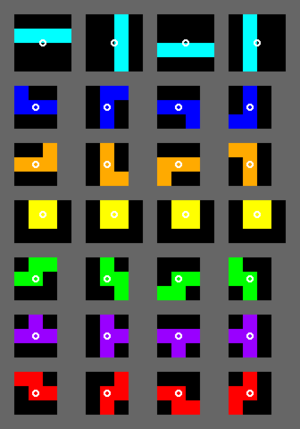Super Rotation System: Difference between revisions
*>Tepples SRS illustration |
*>Tepples m that's SRS not ARS |
||
| Line 1: | Line 1: | ||
[[Image: | [[Image:SRS-pieces.png|thumb|All rotation states of all seven tetrominoes. From top to bottom: I, J, L, O, S, T, Z. The circle doesn't appear in the game; it helps to illustrate the axis on which each tetromino rotates.]] | ||
'''''Super Rotation System''''', or '''''SRS''''' is the current [[Tetris Guideline]] standard for how [[tetromino|tetrominoes]] behave, in a broad sense. SRS represents where and how tetrominoes spawn, how they [[rotate]], and what [[wall kick|wall kicks]] they may preform. In [[Tetris The Grand Master 3 Terror-Instinct|TI]], a player may choose between ''World'' and ''Classic'' rotation styles. ''World'' closely resembles SRS, and ''Classic'' closely resembles the rotation styles of its predecessors [[Tetris The Grand Master|TGM]] and [[Tetris The Absolute The Grand Master 2|TAP]]. [[Henk Rogers]], in his effort to unify all new Tetris games into the Tetris Guideline, required [[Arika]] to include SRS, which they named ''World''. SRS traces its routes back to 1991 when [[BPS]] introduced its signature third and fourth orientations for the ''S'', ''Z'', and ''I'' tetrominoes in their [[Tetris 2 and Bombliss|Tetris 2+Bombliss]]. Later would come flipped-side-up spawned ''T'', ''L'', and ''J'' tetrominoes and flexible new wall kicks. Probably the most accurate SRS finds itself in BPS's latest games [[Tetris Worlds]] and [[Tetris Deluxe]], which both feature exact same rotation styles. | '''''Super Rotation System''''', or '''''SRS''''' is the current [[Tetris Guideline]] standard for how [[tetromino|tetrominoes]] behave, in a broad sense. SRS represents where and how tetrominoes spawn, how they [[rotate]], and what [[wall kick|wall kicks]] they may preform. In [[Tetris The Grand Master 3 Terror-Instinct|TI]], a player may choose between ''World'' and ''Classic'' rotation styles. ''World'' closely resembles SRS, and ''Classic'' closely resembles the rotation styles of its predecessors [[Tetris The Grand Master|TGM]] and [[Tetris The Absolute The Grand Master 2|TAP]]. [[Henk Rogers]], in his effort to unify all new Tetris games into the Tetris Guideline, required [[Arika]] to include SRS, which they named ''World''. SRS traces its routes back to 1991 when [[BPS]] introduced its signature third and fourth orientations for the ''S'', ''Z'', and ''I'' tetrominoes in their [[Tetris 2 and Bombliss|Tetris 2+Bombliss]]. Later would come flipped-side-up spawned ''T'', ''L'', and ''J'' tetrominoes and flexible new wall kicks. Probably the most accurate SRS finds itself in BPS's latest games [[Tetris Worlds]] and [[Tetris Deluxe]], which both feature exact same rotation styles. | ||
Revision as of 03:57, 26 May 2006

Super Rotation System, or SRS is the current Tetris Guideline standard for how tetrominoes behave, in a broad sense. SRS represents where and how tetrominoes spawn, how they rotate, and what wall kicks they may preform. In TI, a player may choose between World and Classic rotation styles. World closely resembles SRS, and Classic closely resembles the rotation styles of its predecessors TGM and TAP. Henk Rogers, in his effort to unify all new Tetris games into the Tetris Guideline, required Arika to include SRS, which they named World. SRS traces its routes back to 1991 when BPS introduced its signature third and fourth orientations for the S, Z, and I tetrominoes in their Tetris 2+Bombliss. Later would come flipped-side-up spawned T, L, and J tetrominoes and flexible new wall kicks. Probably the most accurate SRS finds itself in BPS's latest games Tetris Worlds and Tetris Deluxe, which both feature exact same rotation styles.
See also
- Twists, illustrating some SRS wall kicks